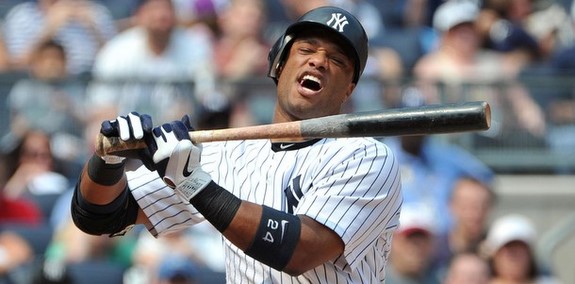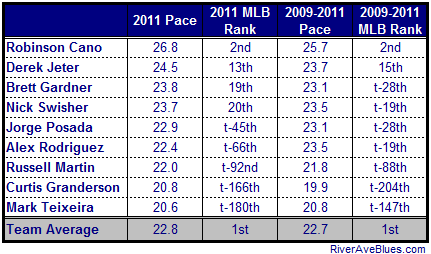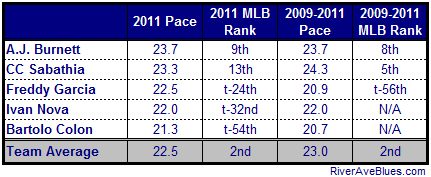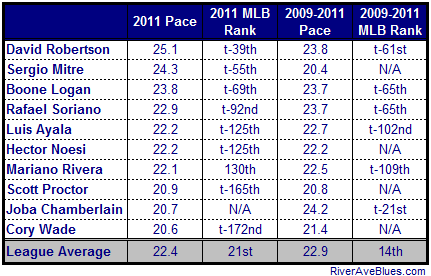
If you’ve been following the Yankees for long enough, you’re well aware that their games usually take an eternity to play. They have patient batters who work deep counts and an offense that scores a lot of runs, and playing in the AL East means they face a bunch of teams built the same way. More pitching changes are made these days made as bullpens become more specialized as well, and that lengthens the game quite a bit. The Red Sox had the longest average time of game at 3:13 in 2011, and the Yankees were second at 3:08. That’s a lot of baseball.
Although we have a general idea of why the Yankees played such long games in 2011, I wanted to get an idea of who specifically was responsible. To do so, I used the “pace” data available at FanGraphs. It’s compiled from PitchFX and tracks the time between pitches within a single plate appearance, so not the time between the last pitch of one plate appearance and the first of the next. The average pace across MLB was 21.6 seconds last year, with both leagues right there (AL was 21.6, NL was 21.7). Let’s break it down into the three major components of the team…
Starting Lineup
For the most part, we can deduce who the culprits are. Nick Swisher always seems to take his sweet time between pitches, as does Derek Jeter. Mark Teixeira doesn’t spend much time fidgeting around between pitches, and neither does Curtis Granderson. Let’s look at the pace data…
 (min. 350 PA for ’11 and 1,000 PA for ’09-’11)
(min. 350 PA for ’11 and 1,000 PA for ’09-’11)
Cano is second only to Carlos Pena in both samples, and not by a small margin either. Pena leads him by 1.6 seconds in 2011 and 1.9 seconds from 2009-2011. That’s pretty nuts, the guy takes nearly half-a-minute between pitches. Cano ranking so high surprised me, but it makes sense when you stop to think about it. He’s always walking around the catcher and umpire and fixing his gloves between pitches. It makes sense. The rest is as expected, with Jeter, Gardner, and Swisher ranking well up there and everyone else further down the pack.
For what it’s worth, there’s basically no correlation between pace and wOBA. Using the ’09-’11 data, I get an R-squared of 0.0898 when I plot the two stats against each other. An R-squared of one means a perfect correlation while an R-squared of zero means no correlation. It’s worth noting that several former Yankees — specifically Jerry Hairston Jr. and Hideki Matsui — also rank pretty highly in terms of 2009-2011 pace. There are 234 players in our 2011 pool and 225 players in our 2009-2011 pool, just so you know.
Rotation
I don’t think there is anything more annoying in baseball than a pitcher who takes an eternity between pitches. Josh Beckett drew some ire last year for his painfully slow pace, and Steve Trachsel was not-so-affectionately known as The Human Rain Delay for the same reason. Rafael Betancourt also has a reputation for taking his sweet time between pitches. Let’s see where the Yankees starters ranked in 2011…
 (min. 100 IP for ’11 and 300 IP for ’09-’11)
(min. 100 IP for ’11 and 300 IP for ’09-’11)
Unsurprisingly, the slowest working pitcher in baseball last year was Beckett at 26.9 seconds. In fact, the four slowest working pitchers last year all have Red Sox ties: Beckett, Brad Penny, Erik Bedard, Jon Lester. Penny is a few years removed from his stint in Boston, however.
The Yankees’ five starters last year are pretty high up there on the leaderboard, which consists of 137 players. Colon and Nova didn’t qualify for the 2009-2011 player pool, which is 126 guys deep. Two of the three Yankees that did are really high up there, and it’s worth mentioning that former Yankees hurler Javy Vazquez is at 22.8 seconds while Andy Pettitte is at 21.3 seconds. Click the link below the table, and you’ll see that the top of the pace leaderboard is dominated by AL East pitchers, which I doubt is a coincidence. The whole lotta grinding out at-bats happens in the division.
The old adage says that a pitcher who works quickly helps keep his defense on their toes, but it doesn’t show up in ERA (R-squared of 0.0006 using ’09-’11 data). That doesn’t mean it’s not true though, the defense may very well be more “into the game” with a quick pitcher, but it hasn’t yielded any significant benefits in recent years. Just FYI, the R-squared between pace and FIP is 0.00007. For all intents and purposes, that’s zero correlation.
Bullpen
Before I dug up the bullpen data, my hunch is that relievers would have a slower pace than starters because it’s the late innings and there are often men on base; these guys then to take their sweet time and think things through before each pitch. Turns out I was right in terms of the league average (by about two seconds), but not as far as the Yankees go…
 (min. 30 IP for ’11 and 90 IP for ’09-’11)
(min. 30 IP for ’11 and 90 IP for ’09-’11)
Our player pools are 202 and 183 players deep for 2011 and 2009-2011, respectively. For whatever reason, the Yankees bullpen works substantially quicker than its peers and at about the same pace as the team’s starters. Why? Your guess is as good as mine. It could be Mariano Rivera’s influence on those around him, could be a team philosophy, who knows. The guys they’ve brought in from other teams were also quick workers, so maybe it’s just dumb luck. That’s pretty interesting though, and it’ll take some work to determine why this is the case and if it’s actually helping any.
The slowest paced reliever over the last three years wasn’t Betancourt (he was second), it was Jonathan Papelbon at a whopping 31.7 seconds. That seems rather excessive. Papelbon and Betancourt (30.8) were the only relievers over 30 seconds while Jonathan Broxton was at 30.0 seconds on the nose.
* * *
Although the Yankees and Red Sox averaged the longest games — and the Mariners averaged the shortest at 2:46 — there was basically no correlation between average time of game and wins in 2011 (R-squared is just 0.066). Some teams just play longer games, and the Yankees are one of those teams thanks to guys like Cano, Swisher, Gardner, Sabathia, and Burnett. Are long games irritating? Sure, but they come with the territory at the moment, so just enjoy the extra baseball.
Leave a Reply
You must be logged in to post a comment.